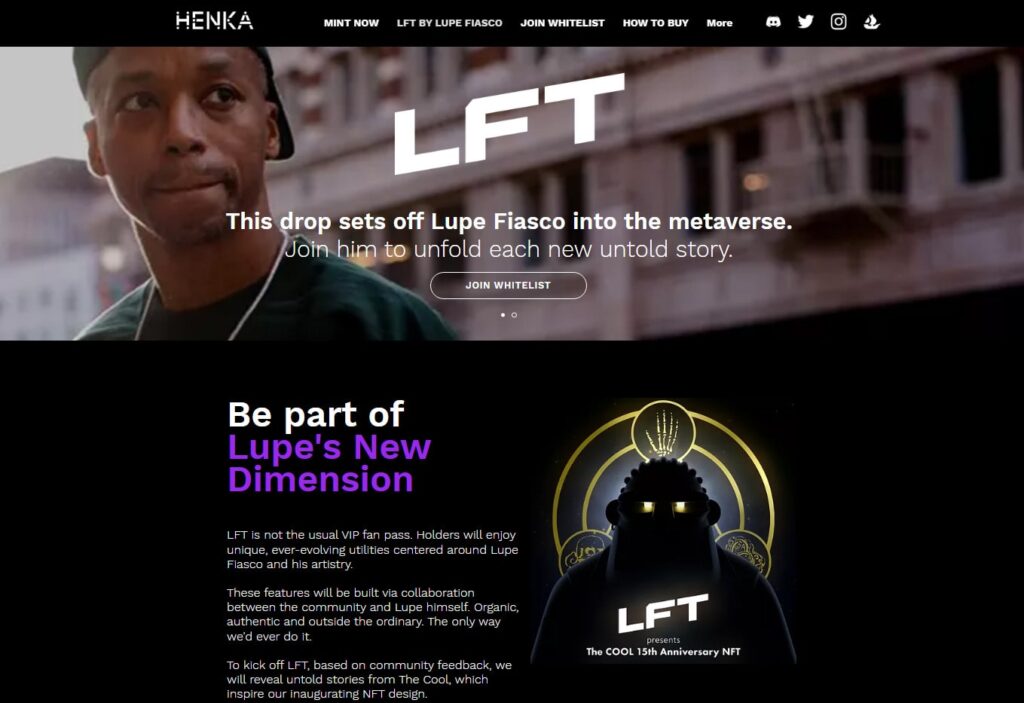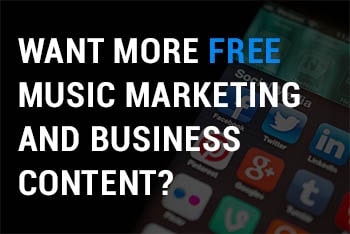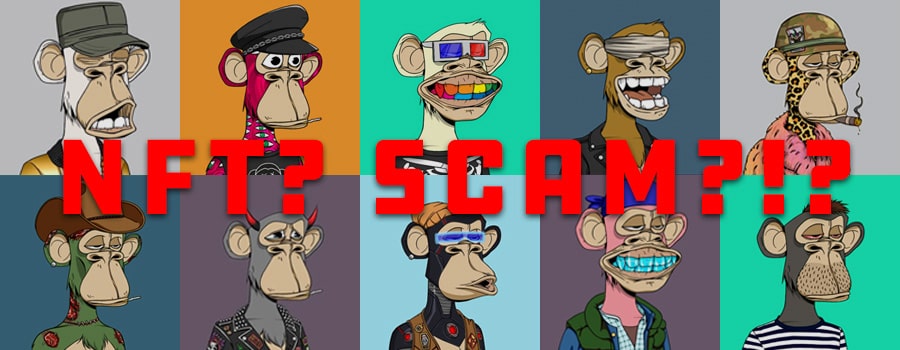
This is the first part of a series on Web3 / NFTs for music artists. In this introductory blog, I explain why so many think that NFTs are a scam and cover the very basics of NFTs and the blockchain.
My hope is musicians will rethink this narrative and keep an open mind because there is a lot of good potential for the music industry as this Web3 space continues to develop. As someone new to this space, I share my experiences with buying into some NFT projects to see if they really are scams.
Within the past 3 years or so, there has been a lot of chatter around NFTs in headlines and various social spaces. On top of that, you also had the buzz words “metaverse” and “web3” constantly being tossed around.
With headlines of record breaking sales, NFTs gained a lot of attention in the music community. In 2021 alone, musician-related NFT projects generated over 86 million dollars in revenue according to research from Water & Music. About two-thirds (64%) of those NFT project sales came from independent artists while one-third (36%) came from major label artists.
Then you have artists like Snoop Dogg, Eminem and even Madonna making headlines for buying NFTs by the Bored Ape Yacht Club (BAYC), spending hundreds of thousands of dollars in the secondary market for what many confused outsiders perceive as “expensive JPEGs.” What is up with all this NFT hype?
But it doesn’t stop there. On a more macro scale, we see companies and big corporations taking initiative. Out of nowhere, Facebook changed their name to Meta during this time. Twitter has added the ability display NFTs as a profile pictures. Instagram is already testing ways to share NFTs on their platform as well.
Global brands like Adidas, Gucci, Nike, Louis Vuitton, Coke-Cola and Samsung have been seen dabbling in the metaverse. Even Walmart is planning something. Is there a shift happening or this one very elaborate scam?
To be fair, all the hype around NFTs hasn’t all been positive. In the same token (pun intended), there is also a lot of criticism of the NFTs, blockchain and the cryptocurrency space as a whole.
NFTs are terrible for the environment!
NFTs are scams!
It’s a money grab!
With so much hype on both sides, it’s hard to know what’s really true. So are NFTS here to stay or are they just a scam-filled fad?
Does everything revolutionary start as a “scam”?
Before getting into what an NFT (Non-Fungible Token) is, it’s important to put into context that new technology in the past faced similar negative reactions and concerns in its early beginnings as well. This is not unique to the emerging Web3 tech.
If you’re actually old enough to remember, think about the internet itself and online shopping (e-commerce) when it was slowly developing back in the mid to late 90s. Many journalists and publications actually thought the thing (the internet) that totally revolutionized our way of life today and how information was shared globally was a bubble or a fad.
There was a lot of fear around scams and getting your credit card information stolen from shopping online. I actually remember ordering a book online with my mom’s credit card from Amazon in the late 90s with no issues. Ironically, it was a book about how to sing which I actually still have buried somewhere.
Even though eBay has become a trusted global marketplace today, there was hesitancy around the idea of selling and buying things from strangers on the platform. It created a situation where scams were easier to pull off if you weren’t careful. I still have my account from 1998 and I think I was a victim of a scam once but it was so long ago so I couldn’t remember the details.
Then you also had the early 2000s with peer-to-peer networks where a lot of illegal file sharing (Napster, Limewire) took place. Not only were MP3s being downloaded, you had full video game files and software that could have dangerous viruses in them. You can tell the fishy files when the file size was only like 300kb when the average MP3 song was at least 2mbs.
Shortly after, you had the rise of social media with platforms like Friendster and Myspace that revolutionized how we would communicate, express our online identities and interact on the internet. Although it wasn’t exactly considered a scam, social media provided opportunities for scams to take place. Even with the earlier forms of communications on the internet like chat rooms and AIM (AOL Instant Messenger), there was a lot of impersonating and creepy behavior going on.
Is blockchain technology that supports cryptocurrencies and NFTs next to follow in this trajectory as the next evolution of the internet, only to be dismissed as a fad or scam?
What is an NFT?
What plays into the confusion around NFTs is talk around the tech itself: blockchain, tokens, crypto wallets, minting, smart contracts, etc. The average person does not need to know how everything works technically, especially as things grow to become widely adopted.
However, it is important to know just enough to understand the value that NFTs have. After all, we know how valuable the internet is to our society but most of us have no idea how all the underlying technology (TCP/IP, UDP/IP, HTTP and FTP) works.
Let’s start with the most basic explanation. A non-fungible token (NFT) is a digital asset that represents ownership of unique things like digital art, a photograph, a song or a video. It is not limited to just things online as you can buy NFTs that represent ownership of physical goods, provide access to real life services and even grant admission to in-person events.
The most unfamiliar word in NFT is ‘fungible’ which means that there can be multiples of a good or an asset where the value is interchangeable, or is all worth the same thing. Currency is a great example of this. If you exchange a $100 bill for another $100 bill, you’re getting the same equal value because the U.S. dollar bill is fungible.
So then ‘non-fungible’ is the opposite where the asset or good is unique. If you make a painting, it would be ‘non-fungible’. Because even if you tried to recreate it, there will likely be subtle differences which makes each version unique and not technically interchangeable in value.
Here’s another way to look at it. If you buy a concert ticket from Ticketmaster, it provides you admission to the show and an assigned seat location to watch. Since each seat in the venue has a unique number, you can say that the ticket for the concert is non-fungible.
If the concert only has general admission, you can say that the ticket is fungible since all tickets are the same because it provides equal value no matter which ticket you bought for that show.
Think of an NFT as a medium or vehicle to provide value, grant access or offer utility (benefits) from owning it. Many things in our society today could eventually become NFTs like concert tickets, a passport, driver’s license, company rewards programs and season passes. Take Starbucks as an example. They began launching their NFT loyalty program called Starbucks Odyssey in late 2022.
Now the key to understanding the value of NFTs lies in the technology that supports them, the blockchain.
What is a blockchain?
A blockchain is what allows for cryptocurrencies (fungible tokens) and NFTs (non-fungible tokens) to exist on the internet where ownership can be publicly verified.
What is it exactly? A blockchain is a system for recording and storing information, like a ledger, except copies of this system live on a decentralized network of computers through the internet. It is essentially a public digital database of online transactions that anyone can view, but it cannot be hacked or modified without proper permissions.
In today’s society, private databases are often centralized in one location with the respective company or organization that owns it. This leaves it more susceptible to hacks and unauthorized access.
With the blockchain, the ledger is duplicated and distributed across the network of computers that are connected to the blockchain. When there’s an update to the ledger, like if you were to sell an NFT from your crypto wallet and transfer ownership to someone else, the transaction needs to be verified first before it updates on all the other computers in the blockchain network. This allows only the person who has the private keys to a crypto wallet to authorize that transaction and update the blockchain in the entire network.
You can look at the various blockchains out there as an additional layer to the internet that allows for publicly verifiable ownership of digital assets like cryptocurrencies and NFTs.
Just to Clarify: Technically, the photos, songs, videos and art that is often associated with an NFT are not actually stored on the blockchain itself. NFTs are more like digital deeds or titles, where it shows who owns it and simply points to where the asset is stored online. Even though hearing ‘token’ makes you think of something tangible, in reality an NFT is just metadata.
Are NFTs a scam?
Back to the big question, are they a scam? NFTs are NOT a scam, but…
Because we are still so early, there are definitely negative aspects to NFTs that should be acknowledged and understood.
With how technical and complex things are now, engaging in this NFT space is not consumer friendly right now. This means if you’re not educated enough and careful, it will leave you susceptible to a scam.
First off, “scam” is a strong word that gets associated with NFTs and I think it needs to be clarified. To me, a scam is something that was designed to be misleading or have ulterior motives like taking money without intending to deliver on any promises. In other words, there is malicious intent.
Inherently, NFTs are not scams, but there are definitely some projects that are created by random, anonymous people with the sole purpose of taking your money and ghosting. This is why doing research is extremely important and knowing who the team is behind a project. It’s easy to create a Twitter account and play it off as this new, cool NFT project to unsuspecting newbies.
We also need to distinguish when something “is” a scam or can open up opportunities for scams to occur. Because of how new and unregulated the NFT and cryptocurrency space is, it makes it very vulnerable for scams to happen.
For example, there are so many scammers preying on new people on Twitter and Discord servers, two very popular social media channels that NFT projects use. They employ a variety of different tactics to trick people into clicking fake links that will drain their cryptocurrencies and NFTs. When I first got started, every Discord community I entered for these NFT projects had scammers sending messages to me left and right.
Here are some popular scenarios:
- Hackers will get access to someone legitimate in a NFT project, like a community manager on Discord, and send out malicious links to the community that drain their crypto wallets. It will usually be disguised as a limited “surprise” NFT release.
- Hackers can gain access to a social media account of a project and send phishing links through direct messages that look real because it is coming from the official account. Again, it’s usually played off as a “surprise” drop but don’t fall for it. Projects will never do surprise drops ever.
- Scammers can create a Discord account or social media profile to look like they are a part of the support team for a particular project. They will seek out people who have a technical problem with minting (paying to generate your personal NFT within a project) and reach out to them to “help” resolve their issue. Instead, they’ll try to extract the seed phrase (password) to your crypto wallet to take all your assets, which is equivalent to giving the door keys to your home. Never give your seed phrase to anyone ever.
- Scammers will send out free NFTs or tokens that will show up randomly in your crypto wallet. Interacting with them in any way, like trying to sell it, could leave you vulnerable to having your assets drained. Always ignore any NFTs you don’t recognize in your crypto wallet.
Because this technology is decentralized and it is not regulated by the government, you’re on your own if you become a victim of a scam. In rare cases, you may be able to get your stuff back because someone in the community buys it back for you.
On the other hand, you have projects that are backed up by well known, credible people like celebrities, actors, athletes and musicians. The problem right now is that most NFT projects in general will fail, no matter how famous the people behind it are or the name it is attached to.
So when you have a project that fails and people lose money, it’s easy to call it out as a scam. But there can be a lot of different reasons why a NFT project flops. The crypto web3 space is still very volatile which does not help the cause.
There are likely a small percentage of projects by celebrities that are simply cash grabs, but I think most fail because it’s actually not easy to launch and sustain a NFT project. It requires a lot of work and resources along with a competent team. But even then, the market for NFTs for the general public just isn’t ripe yet so most of the music NFT projects I’ve seen never sell out.
Even some of the established artists with large fan bases aren’t exactly making a killing. With over a 100 million social media followers, Chris Brown’s NFT project flopped.
The problem can also lie in the fans and their expectations. What drives a lot of hype into a NFT project is the investment potential for people to make money by minting and then flipping or reselling the NFT in the secondary market. When it doesn’t play out that way, it’s easy for speculators to blame others for their own poor choices. Take what happened with Tory Lanez for example.
The big takeaway here is that creating a successful NFT project takes a lot of work and a strong team behind it so failure isn’t a sign of a scam. At this point, it’s not the right time for your average independent artist to think about doing NFTs, but you shouldn’t dismiss it completely.
My First Introduction to NFTs
The following sections are about my personal experiences with NFTs and why you should keep an open mind to newer technology, especially coming from a late adopter like myself. I also touch on the very first NFT projects I bought into.
As a kid, I’ve grown up with computers, video games and the internet at its earlier stages so I’ve always considered myself technologically savvy. My uncle was a computer programmer so I was exposed to these things as a youth. However, I’ve historically been a late adopter as an adult when it comes to newer technology or trends.
I was still on MySpace for years when most of my network moved on to Facebook. I was still using my dumb phone while people were browsing the internet on their Sidekicks and fancy iPhones. When music streaming started to become mainstream, I was still loading my MP3s in iTunes to transfer to my iPod.
Although I found blockchain technology intriguing in 2014, I never got into cryptocurrency, like Bitcoin, when I first heard about it. It was never because I was skeptical or had any negative opinions about these newer technologies.
Looking back now, I believe it was because I was so comfortable with the way things were that I didn’t want to change my habits. Subconsciously, I avoided the latest shiny thing because it meant that I had to spend time and energy to learn and change my ways.
I first caught wind of NFTs in 2020 on the social audio platform Clubhouse. NFTs were the talk of the town amongst artists and music professionals, but I actually didn’t pay much attention to it and avoided most of the rooms that discussed it.
During this time, I was working with a musician who had been somewhat of an early adopter to the NFT digital art space. I knew he was going deep into the rabbit hole but we never really talked about nor did he try to get me into it. He was literally the only person I knew in my life that even understood what an NFT was.
In the beginning of 2021, I had my very first experience with NFTs through NBA Topshot which are officially NBA-licensed NFTs of short, video highlights of individual players. As someone who is a big basketball fan and into collecting sports trading cards at this time, I decided to give it a try.
There was a lot of hype around making money buying/selling their ‘moments’ (what they call their NFTs) which attracted me and many others into this new space. At this point, my interest and understanding of NFTs were still only surface level as I didn’t see the big picture yet.
However, when I heard NFTs explained in a specific context, that’s when my perceptions finally changed.
I remember listening to a podcast from Gary Vee late in 2021 and what he said really changed my understanding of NFTs and its role within Web3 and the metaverse. It was around the time when Facebook changed its name to Meta and I was so confused by what the metaverse is.
This triggered me to read up on what Web3 and the metaverse were since it was completely foreign to me. After I started piecing things together, it motivated me to not be a late adopter this time. I came to the realization that these new, emerging technologies (Blockchain, NFTs, Augmented Reality, Virtual Reality) were going to lay the groundwork for the new version of the internet. It made too much sense that what’s going on today is our transition from Web2 to Web3.
So by March of 2022, I decided I would do more research and get my hands dirty. Even as technologically comfortable as I was, there was a lot of confusion trying to navigate this space by myself.
The moral of my story is to always keep an open mind when new platforms or technology emerges. They often present new opportunities to capitalize, but also will come with risk. As independent artists and entrepreneurs, take the time to do your own research and be quick to judge based on the sensualized headlines.
What follows below were the first NFT projects that I tried out after my research. My goal was to understand firsthand how Web3 would impact independent artists. For obvious reasons, I specifically wanted to focus only on music-related NFTs.
Covering these two projects will serve as a sneak peek into part 2 of this blog series on what music marketing could potentially look like, how fan relationships with artists will change and how artists conduct business in Web3.
1. Lupe Fiasco’s LFT Project
It only made sense that the very first music NFT project I invested in would be tied to one of my favorite artists, Lupe Fiasco.
Although he has released NFTs once before, this would be his first actual NFT project titled LFT. Buying his NFT (called a LFT Pass) serves like a VIP / membership pass that grants you various perks including:
- A free ticket to an upcoming live show.
- A signed museum grade print of his newest album cover.
- Exclusive color vinyl variation of his newest album for only LFT holders.
- Access to a Discord community with other dedicated fans.
- Free mint of a randomly generated art profile picture NFT from his collection that celebrates the 15 year anniversary of his The Cool.
As long as you have a LFT pass in your crypto wallet, you can redeem special benefits as they come up. So far, he has followed through with everything promised so far with more to come.
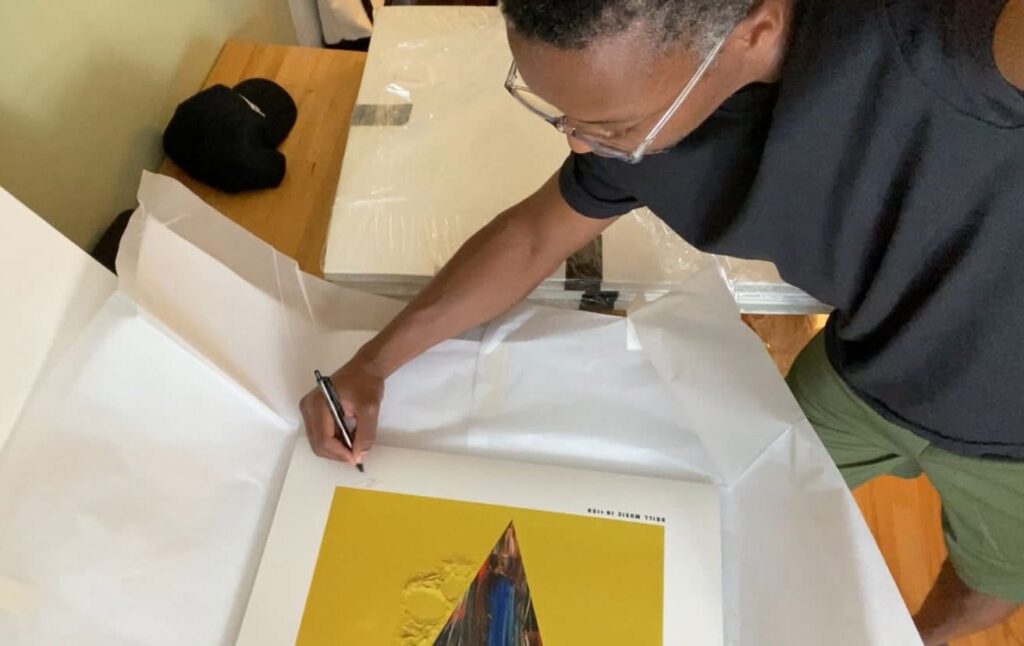
So what was Lupe Fiasco’s motivation for such a project? He understands NFTs as a financial / investment instrument for trading, but also there’s a collectability side of it with the art. You can set up NFTs so that the creator can get small royalties every time it’s sold in a secondary marketplace like OpenSea.
For Lupe Fiasco, this project wasn’t about a money grab. In fact, he stated he actually lost money so far but he understands this is a long term play.
Originally, 1,800 LFT passes were offered up for mint/sale at around $300 each, but only 529 sold. This is surprising considering the millions of fans he has worldwide, but it shows you how skeptical, maybe even cynical, people are of NFTs and its “scam-like” nature.
As an artist, not only did he want to offer fans real world utility and special experiences, he sees NFTs as another canvas.
In this specific case, he wanted to use NFTs to breathe new life into his previous music projects and create new narratives in ways he couldn’t do before. He did this with a generative NFT art project called The Cool By LFT, which celebrates the 15 year anniversary of its release.
For those not familiar, generative art is when an algorithm randomly generates the digital art work based on pre-designed elements and a combination of traits to make it unique. It’s like a blind or mystery box that creates hype since you don’t know what you’re going to get. There are usually specific traits that are more rare than others making them generally more desirable in the community.
In this case, the NFT art is based on one of the 3 main characters highlighted in the album’s story. The Cool, aka Michael Young History, was voted over The Streets and The Game by the NFT Discord community to be the central focus of the generative art.
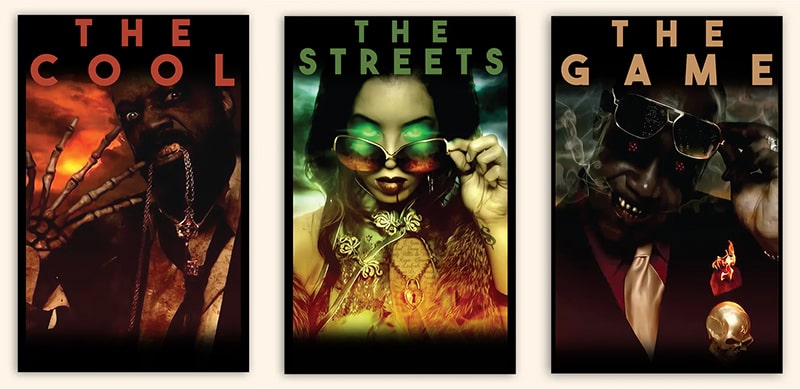
The various traits used in this NFT collection are based on the storyline of his album The Cool. For example, his right hand is bone because it represents the rotting away of his righteousness, of his good, from being raised by The Streets or the hood.
If you view “The Cool by LFT” project on OpenSea, you can browse and see all the different variations, how rare each trait is and who else has that trait.
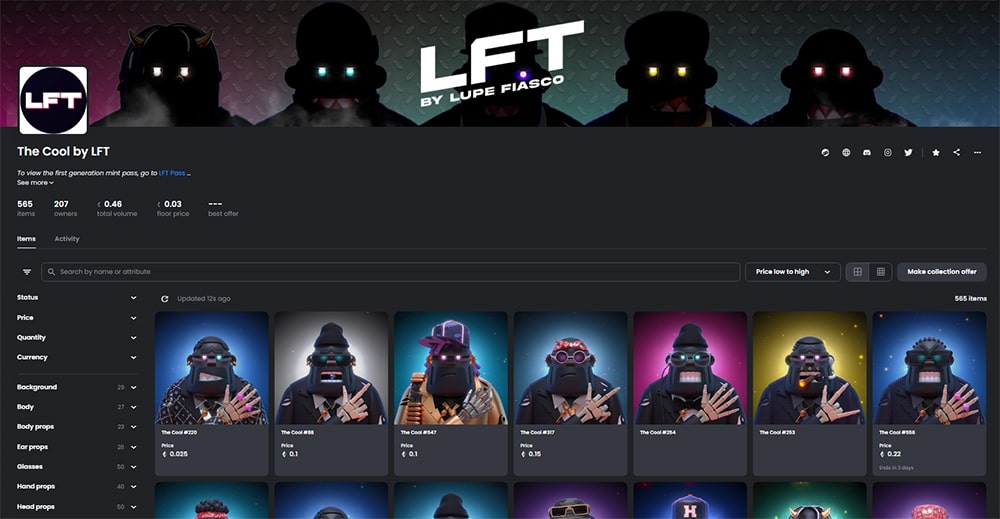
Lupe Fiasco created custom versions of the NFT which he gifted to his celebrity friends: Stephen Curry, Ben Baller, Bun B and Mike Shinoda
2. Royal: Bigboi – Kill Jill
The most exciting concept with music NFTs I’ve been intrigued by is the idea of having fans “own” equity of their favorite songs and earning royalties from it. When I originally heard about what Royal was doing, I was immediately interested in trying it out.
Royal is a Web3 company, co-founded by EDM artist 3LAU, that sells NFTs that do just that. They call them LDAs (Limited Digital Assets). LDAs grants its token holders a portion of streaming royalties from artists willing to give up a percentage of their royalties from certain songs or even albums. Some artist tokens will come with other additional perks outside the streaming royalties like merch, studio sessions and backstage tickets.
The biggest artists that have done drops with Royal so far are Nas, Diplo, The Chainsmokers and 3LAU himself.
I missed out on the first few drops due to selling out, but I managed to buy in on Big Boi’s Kill Jill drop. For the $300 LDA token, I am entitled to 0.0433% of the 25% of his streaming royalties. If it doesn’t look like much, it isn’t.
For the artist, this was a great deal. Big Boi generated $173k by selling 25% of all his streaming royalties to LDA holders moving forward for a song he released in 2017. Even though the song has over 55 million streams on Spotify alone, it wasn’t going to offer a good return on investment for fans based on what we learned from their first round of payouts.
In late July of 2022, Royal officially made payouts for the first time to LDA holders of their earlier drops. One of the tracks that paid out was the Nas “Rare” LDA.
For a $99 gold token, you get 0.0113% of the 50% streaming royalties that Nas offered. With over 14 million streams since the song was released in 2021, the payout for the gold edition turned out to be $2.98. The resale price of a gold token goes for over $200 dollars.
But to be fair, this is all still new so there’s things that need to be worked out in terms of pricing of tokens and setting expectations. It’s also not all about making money as many fans will buy it to collect something from an artist they like. There’s a novelty about being able to say that I “own” a small percentage of a song from my favorite artist.
As cool of a concept as it is, NFTs that payout music royalties are still risky and speculative. We’re far from seeing this concept fully polished any time soon, but I’m very excited by the potential and what this could look like for independent artists in the future.
Conclusion
As excited as I am for NFTs and how it could change the music industry for independent artists in so many ways, this isn’t going to be a smooth ride. Blockchains are far from perfect and it’s going to take time for new technology to develop and work out the kinks.
There’s too much risk and many challenges in this space that it’s not going to be worth the trouble. We are still a far way from mainstream adoption as most of your fans are not Web3 ready.
With all this being said, it’s also not an ideal time for most artists to experiment in this space just yet. It’s too early. However, I do encourage artists to keep a close eye and maybe even experience things first-hand as a consumer to get familiar.
But clearly, it is not a scam.
The integration of Web3 technology into the current infrastructure of the internet is going to be a long process, but it’s hard to not see its potential on the horizon. The first two projects I shared above are a small glimpse of what could come.
In my next blog, I’ll go into more details on what the music landscape could potentially look like for independent artists in the next few years based on some of the developing platforms and cool projects that are currently going on today.
BONUS:
Some of my blog readers may know that I’m a big Gary Vee fan and supporter. Here’s a great video he put out that explains why it’s not a scam and helps to paint the picture of how NFTs will become mainstream.




